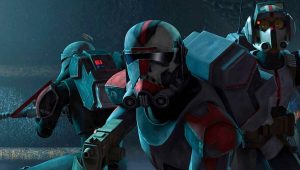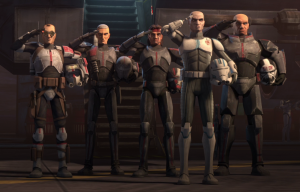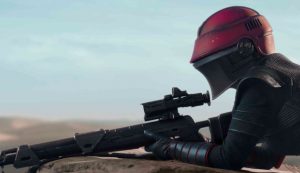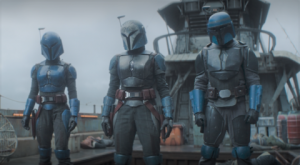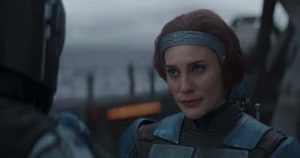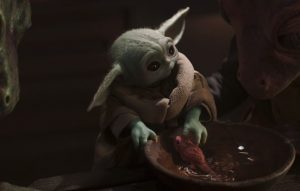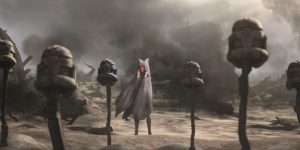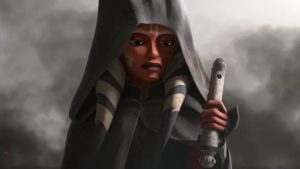SPOILERS FOR THE BAD BATCH AHEAD!
It’s been almost two months since The Bad Batch premiered on Disney+, and you may have noticed that in all that time I haven’t been reviewing episodes weekly. Make no mistake, I’ve kept up with the show, and now that it’s nearing the end of its first season I’m back with what I hope will prove to be consistent weekly reviews for the final seven episodes, but the slow-burn episodic nature of the story made it difficult for me to commit to a weekly format with my reviews. I don’t regret that decision, but I will say this: in the time that I haven’t been reviewing it, The Bad Batch has gotten progressively better and better.

Just as I had hoped, the series doesn’t shy away from exploring complicated and surprisingly mature topics – take, for example, today’s episode, which starts getting to the heart of the extraordinarily messy political situation left in the wake of the Clone Wars between the Old Republic and the recently defeated Confederacy of Independent Systems (or Separatists, as they were colloquially known during the Clone Wars). The Separatists were portrayed as the “bad guys” throughout the war, and with their armies of faceless droids and Sith Lord leadership, it wasn’t exactly hard to see why.
But only a handful of people in the Star Wars universe are aware at this time that Sheev Palpatine, whose Galactic Empire swiftly usurped the Old Republic after the defeat of the Separatists and the Jedi Purge, had not only engineered the conflict, but had been secretly puppeteering both sides – so only the audience gets to fully appreciate the irony of the Separatists remaining devoted to their cause after the war’s end and by default becoming “good guys”, leading to a brutal crackdown from the Emperor whose ascent to power is attributable to hijacking their cause in the first place…or the fact that Separatist tactics were later adopted by the Rebels who would go on to fight in the name of restoring the Old Republic.
Basically, the galaxy is in chaos. And when the Bad Batch are called in to rescue a former Separatist senator on the planet Raxus who has been arrested by Imperial forces, it starts an interesting conversation about who’s really “good” nowadays. Is anyone? Something I’ve always loved about Star Wars is the idea that Light and Dark co-exist in all of us, making it our responsibility to find balance in ourselves: because the Dark Side of the Force is not evil by nature, no more than the Light Side is inherently good – an important lesson that both Jedi and Sith failed to learn in their pride. It’s part of what makes the clear-cut “good triumphs over evil” ending of The Rise Of Skywalker so underwhelming in hindsight, because it reduces Light and Dark to being simply Good and Evil, without any nuance.
This episode of The Bad Batch begins to reverse some of the damage caused by The Rise Of Skywalker, highlighting both the humanity in characters our protagonists have always known as traitors and the moral gray zone in a character they’ve come to love – which is already a compelling enough concept as it is, but the real kicker is that the second character in question here is none other than sweet innocent Omega (voiced by Michelle Ang), who proves to be quite the shrewd businessperson and money-manager while racking up wins at dejarik (the hyper-aggressive holographic version of chess which has reappeared several times in Star Wars since its introduction). I mean, should we expect anything less of a character who was recently revealed to be Jango Fett’s exact genetic copy and the closest living relative of Boba Fett?

As for the other character, our imprisoned Separatist senator Avi Singh (voiced by Alexander Siddig), he’s a humanist who stands up to the Empire, recognizing in their blatant suppression of free speech the same authoritarian qualities he condemned in the New Republic (very timely episode, this). It’s admirable that he chooses to stand up to the Empire during a ceremony in which he is being pressured (quite literally, with stormtrooper guns at his back) to declare the Separatist movement dead and hand control of Raxus over to Palpatine – but his action proves reckless, and ultimately requires the Bad Batch to save him and take him off-world to escape from the Empire’s vengeance.
Perhaps therein lies an interesting parallel between Omega and Singh. Omega uses her “darker” qualities for good, to help the Bad Batch pay off their debts to the criminal entrepreneur Cid (voiced by Rhea Perlman) and earn herself a full-time place on the team, where Hunter (voiced, like all the Clones, by Dee Bradley Baker) realizes that her uncanny strategizing skills can be put to good use. But Singh, an almost cartoonishly “good” character with no understanding of the decisive action required from him, lacks those very same skills and ends up blowing a chance to help his people on the ground where his help would matter most. Star Wars has a lot of characters like these in authority positions where they do about as much good as their equivalents in real life: the perpetually concerned moderate Republicans and the willfully ineffective moderate Democrats.
A character who does take bold action is Singh’s trusty assistant, an RA-7 protocol droid named GS-8 (voiced by Sian Clifford), who contacts the Bad Batch and helps to rescue the senator from the chamber where he’s being held captive, while taking efforts to protect his estate and belongings from wanton destruction. And when you put it that way, she sounds a lot like any of the incredibly brave staffers and interns who helped protect the U.S. Capitol earlier this year, rushing Senators and Representatives to hiding places while making sure classified information and electoral ballots didn’t fall into the hands of domestic terrorists. I doubt this parallel was intentional, if only because the timing probably wouldn’t line up, but it’s still worth noting.
The action scenes at the senator’s estate are very well-choreographed, making good use of the Bad Batch’s individual talents – although, interestingly, this is one of their first times fighting the Empire’s new legions of stormtroopers, and I noticed they had their guns set to stun for most of the battle. Clones are used to mowing down rows of droids, but aren’t quite as accustomed to turning on other sentient beings – with one notable exception. As the show quietly lays the groundwork for stormtroopers supplanting Clones (and continues to offer no valid explanation for why the Empire views this as a profitable exchange), I wonder if this will ever be touched on again.

Heading into next week, it’s pretty cool that Omega will finally get to join the Bad Batch on all their missions, although I’ll miss getting to check in with the endearingly practical Cid and her crew more regularly. Omega is this show’s true star and I appreciate that she’s easing into that role – not so abruptly that it feels like a heel-turn for her shy, reserved character, but not so slowly that it feels grating, either. Basically, Omega is doing in a single season of The Bad Batch what Baby Yoda still hasn’t done in two seasons of The Mandalorian, which is to become a reliable team-player. I’m gonna end this here before I start ranting about how Disney+ is exploiting Baby Yoda for cuteness without developing the character further, but you get the gist.
Episode Rating: 9/10
